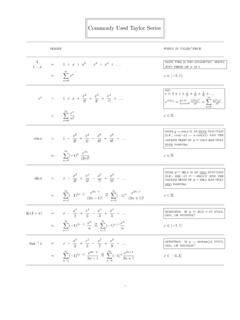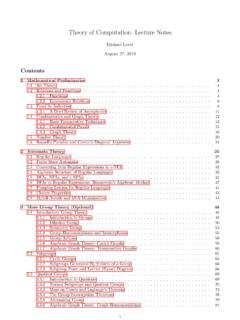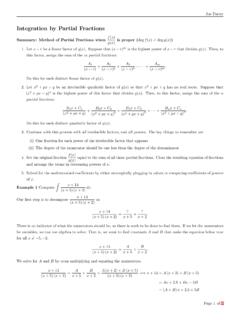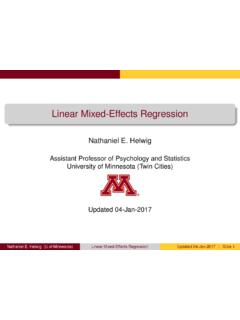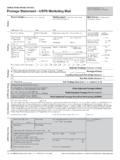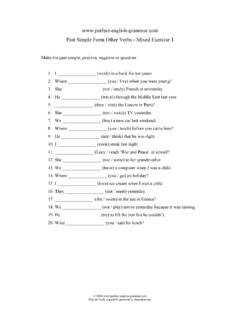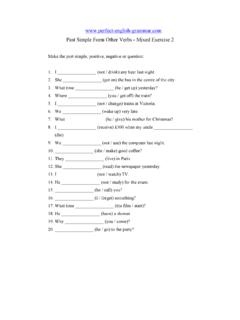Transcription of Game Theory: Normal Form Games
1 Game Theory: Normal form GamesMichael LevetJune 23, 20161 IntroductionGame Theory is a mathematical field that studies how rational agents make decisions in both competitiveand cooperative situations. It has widespread applications in economics, political science, psychology, biology,computer science, and data science. Some of the applications include radio spectrum auctions, voting, andorgan donations. These notes introduce the basic strategic form game, also known as the Normal form ModelIn this section, we formally define the Normal form game. Let s begin with some intuition. A Normal formgame has a set of players. Each player has a set of strategies. These players each select a strategy and playtheir selections simultaneously. In this manner, no player is responding to another s selection. Furthermore,we think of the players strategies as setting the rules of the game. Finally, the selection of strategies resultsin payoff or utility for each player.
2 Each player s goal in a game is to maximize utility. Each player is awareof the structure of the game; that is, the other players strategy sets and payoffs. The Normal form game willnow be formally 1( Normal form Game).A Normal form game is a three-tuple [N,(Si)i N,(ui)i N] whereNisthe set of players,Siis playeri s strategy set, andui: i NSi Ris playeri s payoff or utility sequence of strategies (s1,..,sn) i NSiis referred to as a strategy addition to the assumptions that the players are economically rational and play at the same time, it is alsoassumed that the structure of the game is perfectly known. In other words, each player knows every player sstrategy set and utility s examine an example of a Normal form game, the standard Prisoner s 1(Prisoner s Dilemma).In this game, the police have two accomplices of a crime in separate are each offered a deal: implicate the other prisoner and earn a reduced sentence if the other playerremains silent.
3 If both players remain silent, they each end up in jail for two years. If both players implicateeach other, they each go to jail for five , we have two playersN={1,2}. Each player has the strategy setSi={Quiet,Fink}, and the utilityfunction of the formui:Si Si R. If both players play Quiet, they each earn utility of 2; and if both playFink, they each earn utility of 5. If one player plays Quiet and the other Fink, they earn utilities of 10 and 1 represent the Normal form game using the following matrix known as apayoff matrix. Player 1 s strategiesare on the left-side while Player 2 s strategies are on the top of the matrix. Each cell represents the payoffs ofthe form (u1(s1,s2),u2(s1,s2)) for the selected strategiess1 S1ands2 2 QuietFinkPlayer 1 QuietFink 2, 2 10, 1 1, 10 5, 51 Not every Normal form game can be represented as a matrix. When we have more than two players orcontinuous strategies, tables are not very helpful.
4 Let s consider a second example of a Normal form game: theCournot 2(Cournot Duopoly).In this game, we have two players again:N={1,2}. Each player is afirm producing the same, identical good. The market sets the price for the good based on the total amountproduced by the two firms. The two firms compete in the quantities of the good they each produce, incurringa fixed costc >0 for each unit of good produced. Each firm seeks to maximize its own profit. Suppose theinverse demand function (the price function) is given as follows wherea,b >0:P(q1,q2) ={a b(q1+q2) :ifq1+q2 a/b0 :ifq1+q2> a/b(1)Each firm has the strategy setSi=R+, indicating the quantity of the good it can produce. Each firm alsohas the utility function of the formui:R2+ Rgiven byui(q1,q2) =qiP(q1,q2) cqi. Since the strategies areuncountable, it is pointless to construct a payoff matrix to help in analyzing the Solving Games and Nash EquilibriumRecall that each player in a given game seeks to maximize its utility.}
5 How do agents select strategies? Whatis the solution concept for a game? The first notion of comparison is rather intuitive and refer to it as strategy dominance. Basically, if strategysiyields at least as good a payoff as strategysjregardless of the other agents strategy selections, then why would the player ever choose strategysj? Wefirst introduce the following notation. Leti N. We denote i:=N\{i}. Now we formalize the notion ofdesirable strategies by defining aBest 2(Best Response).Leti Nand letsi Si. The strategysiis a best response of playeriagainsts i S iifui(si,s i) ui(s i,s i) for everys i denoteBi(s i) ={si Si:ui(si,s i) ui(s i,s i) s i Si}asi sbest response correspondenceagainsts i, or the set of alli s strategies that are best responses tos i. Note that every element ofBi(s i) solvesmaxsi Siui(si,s i).Remark:Note that the Best Response Correspondence is only defined for pure strategies here.
6 If we are inter-ested in mixed strategies (which will be introduced later), we consider themixed-extensionof the Normal formgame . The mixed extension of a Normal form game considers the same set of players and utility , each playeri s strategy set in is (Si), where (Si) is the set of all probability distributions overi s strategy setSiin . We then consider the Best-Response Correspondence over (Si) rather s consider an example with a new game, a voting 3(Voting Game).Suppose we have three players,N={1,2,3}and two candidatesA,B. Eachplayer can vote for exactly one ofAorB, soSi={A,B}, for alli N. The three players cast their votessimultaneously. Players 1 and 2 incur utility 1 ifAwins and utility 0 ifBwins. Player 3 incurs utility 0 ifAwins and utility 1 that for anys 1 S 1,B1(s 1) ={A}. Ifs 1= (B,B), player 1 selectings1=Aincurs the sameutility of 0 as selectings1=B. Otherwise, if player 1 selectss1=Aand at least one player of 1 selectsA,then player 1 incurs utility 1 while selectingBmay result in utility 0 if only one of the players in 1 selectsA.
7 In fact, we can say more strongly that for player 1, voting forAis aweakly dominant strategy. This isformally defined as 3(Dominated Strategies).The strategysi Siisweakly dominatedif there exists a second strategy si Sisuch that:ui(si,s i) ui( si,s i) for everys i S i, with strict inequality for at least ones i. Wesay thatsiisstrictly dominatedif the strict inequality holds for alls i S that we have some notion of how a player compares its strategies, the next step is to discern how theplayers select their strategies in anticipation of each other. The solution concept is the Nash , the Nash equilibrium is defined as 4(Nash Equilibrium).The strategy profiles is said to be a Nash Equilibrium ifs i Bi(s i) foreveryi , a strategy profiles is a Nash equilibrium if no player can unilaterally change its strategy andimprove its outcome. Let s apply this reasoning to deduce the Nash equilibrium for the Prisoner s Dilemmagame from Example 1, with the payoff matrix included below.
8 If the two players both select Quiet, thenthey each incur utility of 2. One of the players can unilaterally deviate, playing Fink instead, decreasing itsutility to 1 while the other player s utility is decreased to 10. So (Quiet, Quiet) is not a Nash (Fink, Quiet). Player 2 can unilaterally deviate, playing Fink instead of Quiet to improve its payofffrom 10 to 5. By symmetry, (Quiet, Fink) is not a Nash equilibrium. Finally, consider (Fink, Fink). Byprevious analysis, a single player unilaterally changing from Fink to Quiet will decrease its payoff from 5 to 10. So no player can unilaterally deviate from (Fink, Fink). Thus, (Fink, Fink) is the Nash equilibrium ofthe Prisoner s 2 QuietFinkPlayer 1 QuietFink 2, 2 10, 1 1, 10 5, 5 The first concern is whether every game has a Nash equilibrium. The answer is yes, but not necessarilyin pure strategies. A pure strategy is the selection of a single strategy from the setSiwhich playerialwaysuses.
9 The Nash equilibrium of (Fink, Fink) is the pure strategy Nash equilibrium for the Prisoner s finite Normal form Games , Nash equilibria are guaranteed to exist in mixed strategies, which will be intro-duced later. Additionally, we note that in a symmetric game (that is, a game where each player has the samestrategy set and utility function), there exists a Nash equilibrium where each player selects the same equilibrium of (Fink, Fink) in the Prisoner s Dilemma is actually a symmetric Nash problem of computing Nash equilibria is difficult. Formally, it is a complete problem for the complexityclass PPAD. This means that given an arbitrary game, there is (believed to be) no efficient procedure tocompute a Nash equilibrium for an arbitrary game. Additionally, a game may have multiple Nash all such equilibria as well as selecting the most realistic equilibria are both difficult problems ofinterest. We examine two strategies to help compute pure strategies Nash equilibria: leveraging Games withcontinuous strategy sets and the elimination of dominated Leveraging Example 2, the Cournot Duopoly.
10 Each player s strategy set isR+, an amount to produce. Furthermore,each player has the same utility function, so this game is symmetric. Therefore, we solve for a symmetric Nashequilibrium. Each player seeks to solve maxqiui(q1,q2) = (a c)qi b(q1+q2)qi. We consider the first partialderivative ofuiwith respect toqi, as playericannot varyq i, and set it to 0 to identify potential maximizers:a c= 2bqi+bq i. Solving forqiyields:qi=a c2b q i2As this game is symmetric, there exists a Nash equilibrium where each player selects the same strategy. So weset:qi=q iand solve:q i=a c2b q i2= q i=a c3b3 Note that ifq i a cb, thenqi= 0 is playeri s best Elimination of Dominated the approach in reasoning the Nash equilibrium for the Prisoner s Dilemma. Checking each strategyprofile to determine if it is a Nash equilibrium is tedious. We prove a simple lemma, upon which the approachof eliminating dominated strategies is N.
